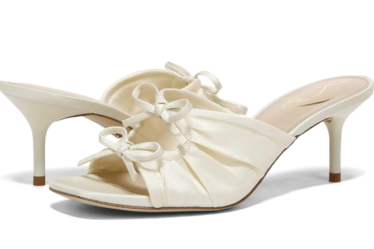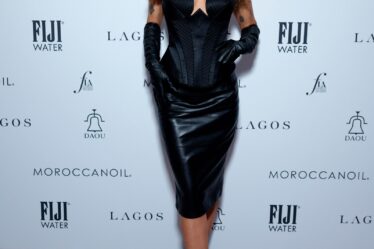
When Besty Han wakes up in the morning, she has a cup of coffee and checks her TribeDynamics dashboard.
“There’s just so many platforms, TikTok, Facebook, Instagram, Pinterest,” said Han, the vice president of marketing for skin care brand Herbivore Botanicals. “If you’re not constantly monitoring it, it’s easy to miss what’s being said about you.”
With its earned media value (EMV) metric, influencer marketing platform TribeDynamics — along with fashion data analysis firm Launchmetrics’ media impact value (MIV) and other competing metrics — aims to make it possible to track it all. The most widely used measures promise to put a dollar value on conversation on social media so that brands’ online impact can be better understood. The two have become in-demand tools for marketers looking to grasp how consumers are engaging with their brand outside its official social media pages.
The metrics are often used to demonstrate success (or slump) in the media, and investors and analysts consider them proof of a brand’s relevance. For an up-and-coming brand, an MIV or EMV on par with a much larger rival’s is something to brag about.
But they have limitations. To start, it’s not always clear how the dollar value of an EMV reading translates into real-world sales. And the metrics themselves don’t indicate the tone of the conversation around a brand — Balenciaga probably wasn’t cheering its EMV spike last fall as it dealt with multiple controversies. Some even think these measures are encouraging brands to pursue ever-crazier stunts to ensure they go viral on social media and inflate their metrics.
“It’s a good high level gut check, but it doesn’t give you the granularity you need to get real insights that shift your business, it’s one signal,” said Richard Oldfield, executive director of media and communications at marketing firm RGA.
What Are EMV and MIV?
As brands embraced social media in the 2010s, they started with the obvious metrics to measure the success of any given campaign: likes, comments and clicks. Soon they realised those numbers did little to show the return on investment of online posts in a comparable way across different platforms; there was no standard way to compare an Instagram comment with a Twitter retweet or a print advertising impression.
That’s where conversation metrics come in. In addition to TribeDynamics and Launchmetrics, there’s Captiv8, GRIN and Karla Otto-owned Lefty, among others. Each has its own methodology. Lefty estimates the number of impressions for each post, and associates a cost-per thousand views of $100 on Instagram, for example. TribeDynamics’s algorithm takes into account the size of a creator’s following, their level of audience engagement, and which platform they are on.
MIV, based on Launchmetrics’ proprietary algorithm, developed specifically for fashion and beauty labels, also measures print media and Chinese social media, including its TikTok equivalent, Douyin. It roots its online measurements in an advertising value equivalent, a metric commonly used in PR to put a dollar value on media coverage of a campaign, drawn from its database for online mentions.
“You need to be able to value all different types of voices and compare them,” said Alison Bringé, Launchmetrics’ chief marketing officer.
These services sometimes reach different conclusions about the same campaigns. Lefty found Celine was the top performing brand on Instagram for the the months of February and March. Tribe said it was Louis Vuitton.
How Are These Metrics Used?
Conversation metrics can be benchmarked against competitors, category averages, or past performance. For example, a brand that stages a fashion show can compare the conversation generated around that year’s event to last year’s, and see what types of creators participated in the conversation and how other brands fared during the season.
Beauty brand Glow Recipe uses EMV to keep tabs on what marketing tactics are working best in which areas. After noticing shoppers talking about the brand online most were spread out across the US, rather than just centred around its home base of New York, Glow Recipe saw an opportunity to invest more in mailers. In 2022, EMV generated by mailers surged, making up 14 percent of its total for the year.
Though the metrics wouldn’t necessarily be benchmarked against sales, said Oldfield, Glow Recipe argues there’s still a connection, especially for smaller, social-native labels.
“As a growing brand, awareness is key to sales … especially in a retail environment where consumers are coming into stores with a TikTok up, asking for that product,” said co-founder Christine Chang.
The metric has become a point of differentiation. For, Glow Recipe time on TribeDynamics’ top EMV-generating beauty brands chart is as important an indicator of success as its status as a top seller at Sephora. The brand has tracked EMV since launch; but in the past few years investors have started asking about it, said co-founder Sarah Lee. It’s a better way to prove a brand has engaged consumers, rather than just riding a wave of buzz.
Being able to point to its name next to mass brands like La Roche Posay and CeraVe, who are creating a similar level of impact with bigger budgets, doesn’t hurt either.
“[Clients] are using it to understand whitespace, to identify potential acquisition targets, to know what brands to be on the lookout for,” said Brittni Starr, TribeDynamics’ senior vice president of corporate marketing.
What Are the Limits?
Because they only show the amount of times a brand is mentioned by various types of content creators — rather than exactly how or why — metrics like EMV and MIV should be looked at as the beginning of the measurement conversation, rather than the end, experts say.
“MIV is really important for looking at the top of funnel activities a brand is doing, then you see how that translates into the rest of the business,” said Bringé.
EMV and MIV don’t answer questions around what people thought about a brand or a specific campaign, and whether activity is leading to sales or pushing consumers to switch from other brands, said Allen Adamson, co-founder of marketing firm Metaforce.
“The challenge in marketing has never been ‘Can media be used to track eyeballs?’ But figuring out ‘what message did they get?’” he said.
During the scandal that ensued after it was accused of sexualising children in an ad campaign in November, Balenciaga’s EMV was $41 million, more than its September total and not far behind its Spring/Summer 2023 fashion week-fuelled October reading of $52 million. December EMV then fell sharply to $11 million.
Still, for many brands, being able to prove reach is huge.
As media becomes more cluttered, Oldfield wonders if the measures are helping fuel a growing list of brands seeking to shock consumers to nab online attention. Just look at recent runways filled with faux taxidermy, spray-on dresses, and prancing models in animal prosthetics.
To most effectively use EMV or MIV, brands should work it into an overarching strategy, said Oldfield. For example, if a brand wants to attract younger consumers, it could pay closer attention to how much conversation it’s generating on their favourite apps.
“Marketing is inherently going to become more digital, more socially driven, more conversational. [Conversation metrics are] a helpful signal of how a brand is standing out.” said Oldfield. “To use them effectively, it has to be against a longer term goal of doing something.”



